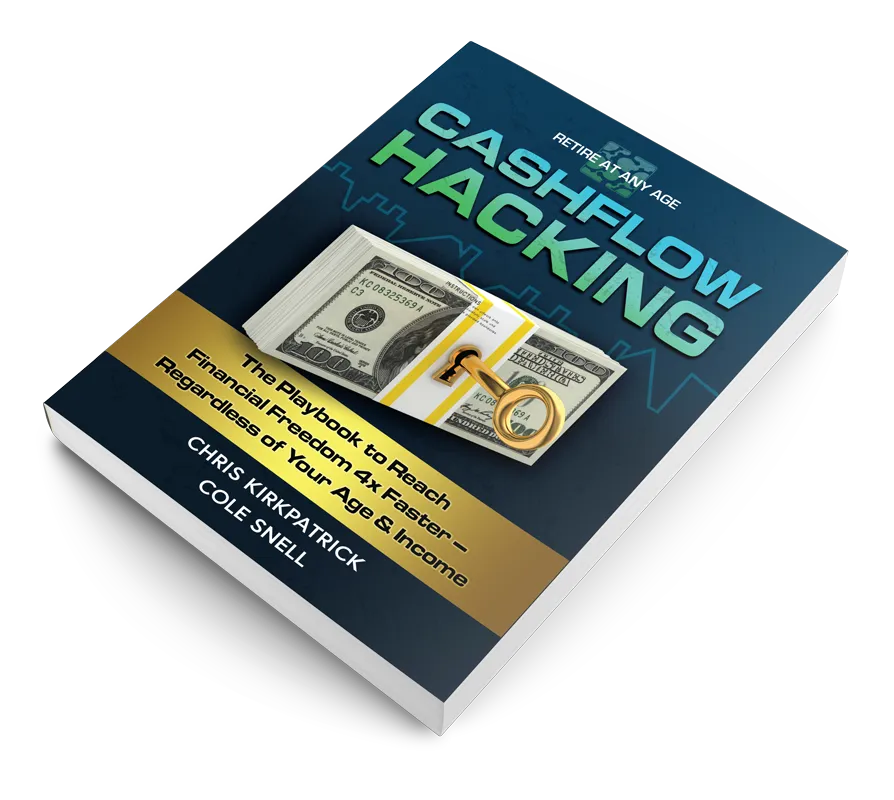
Simplifying Financial Confusion
LEARN CASH FLOW HACKING TO REACH FINANCIAL FREEDOM
Used by 90% of millionaires to reach their financial goals 4x faster

Achieve Financial Freedom Through Cash Flow Hacking

Increase Your Lifestyle While You Build Your Wealth

Position Yourself to Thrive in Market Downturn
YOU SHOULD NOT FEEL OUT OF CONTROL ABOUT YOUR FINANCIAL STRATEGY

Have easy access to your money in case of emergencies and opportunities

Use the investment strategy 90% of millionaires use

You deserve a clear plan to consistently grow your money and avoid market uncertainty

Have a guide and advisor that has your best interest in mind

Do not overpay in taxes

Stop guessing at the best vehicles to protect and grow your money

Buy Term & Invest The Difference Could DESTROY Your Retirement Plan
Below is a transcript of the video that you can find on the LIFE180 YouTube channel.
“Buy Term and Invest the Difference" was once touted by financial gurus like Dave Ramsey, Suze Orman, and Art Williams as the ultimate strategy for retirement planning. In this article, I aim to debunk the concepts surrounding "Buy Term and Invest the Difference”.
I will strive to thoroughly engage with each aspect, but by the conclusion of this article, regardless of your initial stance on the matter, your perspective on "Buy Term and Invest the Difference" will likely undergo significant reconsideration.
Why Is Buy Term and Invest The Difference So Misunderstood?
The misclassification of "Buy Term and Invest the Difference," its misconstrued nature, and its prevalent misrepresentation within the industry and business landscape underscore the necessity to approach it from a different angle to gain a genuine understanding of what truly suits your financial needs.
Here's the crucial point: before delving deeper, it's essential to grasp the concept of "buying term and investing the difference." Let me break it down for you.
The concept of "buying term and investing the difference" boils down to opting for term insurance over whole life insurance and directing the saved premiums towards other investments.
For example, if you're paying $10,000 for whole life insurance and $500 for term insurance, the $9,500 difference is what you're prompted to invest. The idea is simple: buy term, invest the difference, and supposedly achieve financial security and stability. However, the flaw lies in comparing apples to oranges.
I'm not a fan of the "buy term and invest the difference" discourse because it fundamentally compares apples to oranges. Whole life insurance should never be considered an investment. If we're talking about "buy term and save the difference," then that's a conversation worth having. What I find ironic and amusing is that Dave Ramsey himself emphasizes the need for a six-month emergency fund to achieve financial security.
So, let's shift our focus from "buy term and invest the difference" to "buy term and save the difference." This shift in perspective is crucial because whole life insurance doesn't carry the same risk profile or address the same financial needs as investments. They serve different purposes altogether.
Whole life insurance is more closely aligned with addressing the same concerns as a savings account, but it operates as a high-powered savings tool. In this article, I'll illustrate how whole life insurance functions as a robust alternative to traditional savings accounts.
Once you've established the necessity of an emergency fund, the next question arises: what do you do with that money? Let's delve into that crucial decision.
A Look At A Whole Life Insurance Policy As An Emergency Fund
Let's examine the next scenario. We have a 40-year-old individual with a $10,000 annual premium. At the end of the first year, the policy's cash value sits at $7,300, with a death benefit of $176,000.
Over the following years, the individual continues paying $10,000 annually, accumulating a total of $100,000 in premiums after 10 years. By this point, the cash value stands at $106,000, while the death benefit has grown to $339,000. Thus, the net increase in death benefit after 10 years is $169,000.
The intriguing aspect here is that the death benefit outpaced the growth of the cash value. For those adherents of Dave Ramsey who may harbor skepticism towards life insurance companies, this revelation might seem counterintuitive. In the event of death, the insurer would indeed pay out the death benefit, which could be higher than the cash value.
This is because the tax-free nature of the cash value is perpetuated forward, contributing to the continuous increase in the death benefit. As the cash value grows, it seamlessly integrates into the death benefit, resulting in its ongoing escalation over time.
You Can NEVER Self Insure
Now, let's consider another scenario: a term insurance policy for the same individual, with the same health rating, but with a $200,000 death benefit. Priced at $458 per year for a 20-year term, it provides coverage for the specified duration.
Let's consider a hypothetical scenario where you have dependents, such as children. For a period of 20 years, term insurance meets the need for coverage, aligning with the philosophy endorsed by Dave Ramsey. Once your children are independent and out of the house, the need for a $200,000 death benefit diminishes. As the insurance costs escalate over time, Ramsey's advice would be to transition to a self-insurance approach.
The crux of the issue lies in the notion of self-insurance. The reality is, there's no middle ground, you're either insured or you're not. Attempting to self-insure, even with assets like a paid-off house and sound financial positioning, carries inherent risks. The burden of self-insuring can still deplete your financial resources significantly.
Let's consider a scenario where you have a million dollars saved for retirement and you're contemplating self-insurance. Suppose you have a whole life policy as part of your financial plan. If you still have a need to insure $200,000, but you possess sufficient assets to self-insure, your house is paid off, and your financial position is solid, what's the next step?
Indeed, there's an opportunity cost associated with self-insuring. When you allocate $200,000 for self-insurance, that portion of your assets becomes unavailable for other investment opportunities. Consequently, your total available funds shrink to $800,000.
This opportunity cost underscores the inefficiency of self-insurance. It's worth noting that insurance companies exist for a reason. If self-insurance were truly effective, the wealthiest individuals wouldn't hold substantial life insurance policies. The wealthiest people understand risk mitigation and that's where this comes into play. That's really important to understand.
Let's examine the final year of the term policy. This marks the culmination of the term insurance coverage. For proponents of the "buy term and invest the difference" approach, the idea is that instead of spending $200,000 on whole life insurance premiums, you could opt for term insurance at a lower cost, say $4,500, leaving you with $9,160 to invest. By choosing this route, you'd have $190,000 available for investment out of the initial $200,000, which could potentially grow over time.
Let's be clear, I'm not here to debate. Investing the $190,000 over a 20-year span would undoubtedly yield higher returns than what we're seeing here. However, let's not lose sight of the point: whole life insurance isn't an investment. It's not a sound investment strategy and should never be mistaken for one. What whole life insurance offers is a compelling savings alternative.
How Much of an Emergency Fund Should You Have?
My contention is this: while Dave Ramsey advocates for a six-month emergency fund, I believe that your financial approach should resonate with your values and beliefs. At the very least, maintaining a six-month cushion in savings is crucial.
If you're involved in real estate or entrepreneurship, your financial requirements extend beyond the conventional wisdom. In such cases, I'd argue that having two years' worth of liquid accessible capital is essential. This comprises not only an emergency fund but also an opportunity fund, crucial for seizing moments of potential growth and success in your business endeavors.
I firmly believe that everyone should consider incorporating a whole life insurance policy into their financial strategy. It serves as an optimal vehicle for safeguarding your emergency fund. With a whole life policy, you have the flexibility to contribute anywhere between $3,000 and $10,000 annually, ensuring that your emergency fund remains secure and easily accessible when needed.
The 3 Main Benefits of Whole Life Insurance Cash Value
Ultimately, the reason I advocate for whole life insurance is because it serves as a viable alternative to bonds. We're all familiar with the traditional 60/40 bond portfolio. But when retirement approaches, the question arises: what's your plan?
It's widely acknowledged that a retirement portfolio requires a bond alternative or safe money component. This ensures that you have a buffer to avoid tapping into your assets and other investments during market downturns. This principle is universally recognized as a fundamental aspect of retirement planning.
Whole life insurance offers a compelling combination of features: bond-like returns, tax treatment similar to municipal bonds, and liquidity akin to a money market account. This trifecta addresses the need for a bond alternative in your retirement portfolio.
Recent years have highlighted the challenges facing traditional bond investments, with two consecutive years of losses. Moreover, the perceived risk and volatility of bonds have been underestimated, exposing portfolios to higher levels of risk than anticipated.
The beauty of whole life insurance lies in its ability to provide all these benefits with a standard deviation of one. Essentially, it offers a virtually risk-free investment option. With whole life insurance, you're essentially guaranteed not to incur losses, as the insurance company bears the brunt of the risk.
Whole Life Insurance Provides Many Living Benefits
Whole life insurance transcends its traditional role as insurance and emerges as a potent asset, particularly as a volatility buffer. Its true value lies in the access it provides to the accumulated cash value, which in the first case that we contemplated at the beginning of this article amounts to $276,000. Rather than solely serving as a death benefit, it becomes a tool for accessing living benefits. As the cash value and death benefit continue to grow, it's the living benefits that truly shine.
I recount the poignant story of my father-in-law, who in his 70s faced a devastating diagnosis of stage 4 pancreatic cancer. Despite the bleak prognosis of just three months to live, having access to multiple six-figures through his whole life insurance policy afforded him the opportunity to pursue life-saving treatments. This underscores the critical importance of the living benefits offered by whole life insurance, especially in times of dire need.
Despite facing a daunting seven and a half centimeter tumor on his pancreas, which had metastasized to his liver, my father-in-law's access to multiple six figures in liquid assets proved to be a lifeline. Empowered by these resources, he opted for alternative medical treatments, defying the grim prognosis.
Three years later, he continues to enjoy life, playing golf, spending time with his grandchildren, and relishing every precious moment, all because he had the autonomy to direct his medical journey.
He didn't have to endure the constraints imposed by a health insurance company dictating his treatment options. Instead, he had the autonomy to make decisions about his own body and his life's trajectory. This empowerment is where the true power of whole life insurance lies, it grants individuals the freedom to manage their health and well-being on their own terms.
It's imperative to have a plan like whole life insurance in place for retirement. Medical expenses are a leading cause of bankruptcies during retirement. Even if you've diligently saved a million dollars, a serious illness can leave you financially vulnerable.
Qualifying for Medicaid may not be feasible, leaving you exposed to exorbitant healthcare costs. Without proper coverage, the fruits of your lifetime of labor could vanish in the face of medical crises.
The 3 Reasons Buy Term and Invest The Difference Doesn't Work
The shortcomings of the "buy term and invest the difference" approach are multifaceted. Firstly, self-insurance isn't a viable option, it's either insurance or no insurance. Attempting to self-insure incurs opportunity costs, eroding potential investment returns.
Secondly, a crucial aspect of retirement planning is the necessity for a volatility buffer. Traditional investment strategies like the 60/40 portfolio are no longer reliable. Therefore, the "buy term and invest the difference" approach falls short because it fails to provide an alternative for the bond portion of your portfolio in retirement. Whole life insurance stands out as an unparalleled option, offering superior returns with lower risk compared to traditional bonds.
Lastly, and perhaps most significantly, opting for a term insurance policy in retirement deprives you of access to critical funds in the event of serious illness. What if I could demonstrate a method that allows you to access a substantial portion of the death benefit during retirement to address critical, chronic, or terminal illnesses as needed? This capability underscores the profound value of whole life insurance.
This is precisely why I'm vehemently opposed to the "buy term and invest the difference" approach. It reflects a narrow, short-sighted perspective rooted in a scarcity mentality, failing to consider the holistic view of your financial situation when making one of the most pivotal financial decisions of your life.
If you have any questions or want to delve deeper into the power of whole life insurance, feel free to leave a comment in the section below. Additionally, check out the playlist linked below to explore a plethora of videos dedicated to educating you about whole life insurance. There's a wealth of information available, so feel free to browse and find the content that resonates most with you.
The Power of Whole Life Insurance - Playlist
If you found value in this article, I encourage you to share it with others and subscribe to my LIFE180 YouTube channel. Don't forget to hit the bell icon to receive notifications whenever I release new videos. Keep fueling your educational journey, and until the next video, have a blessed and inspirational day.
HOW TO START TAKING CONTROL OF YOUR FINANCES BY MAXIMIZING YOUR CASH FLOW AND PROTECTING YOUR ASSETS

1. Schedule Your Free Clarity Call

2. Create a Free Customized Plan

3. Get Guide to Financial Success
GET YOUR FREE COPY TO STOP USING OUTDATED RETIREMENT STRATEGIES
Cash Flow Hacking teaches you to:
Protect Your Investments
Thrive in bad markets
Reach financial freedom faster

ARE YOU LOOKING FOR:

Cash Flow Hacking teaches you to:
Security to protect your money
Increased cash flow and lifestyle
Inflation protection
Financial certainty in all economic environments
A reduction in taxes
Safe and fast access to your money with no penalties
WHO IS THIS PROGRAM FOR?

People looking for an alternative
Are you looking for alternatives to Wall Street’s “buy and hold” strategy that takes 40 years with uncertain results? Our Cash Flow Hacking strategies provide you the building blocks to get started on the right foot

Passionate Entrepreneurs
Are you looking for a financial strategy that will take your best assets (you and your businesses) and multiply their potential? Our Cash Flow hacking strategies will teach you how to invest for the future without sacrificing building your business

Real Estate
Investors
Are you a real estate investor who is burned out from being a landlord or playing the fix-and-flip game? Our Cash Flow Hacking strategies will provide you with the system to create predictable wealth AND give you the freedom you are looking for.
YOU DESERVE PEACE OF MIND AND A PLAN THAT WILL PROTECT YOUR FAMILY AND GROW YOUR WEALTH
Today you need to be more savvy than ever if you try to go at it alone.
Losing money to inflation, taxes, and just poor investment strategies is leaving you frustrated, feeling out of control and not knowing where to turn. To add to the problem, the market is flooded with advisors who have outdated advice that does not place your best interests first, but instead focuses on charging you a fee that creates guaranteed cash flow for them.
NOT YOU
We believe this is wrong and that your security and best interests should be placed first. We believe you should be in a position where you control your money, your money doesn't control you. We understand because we talk with hardworking people everyday that are losing money in the markets based on old information and feel like they are guessing at the best course of action.
We created the Cash Flow Hacking plan to help you have security and control of your money to take advantage of life's opportunities because you deserve peace of mind with your wealth. The old way of planning for retirement of… Go to school Get a job & save as much as you can in your 401k and mutual funds...is broken.
You have been lied to. Think about it, where else in life does someone tell you that the most certain way to achieve your desired result is to take on more risk? The math just doesn't work, and the results are showing in our country and world. Did you know that 90% of millionaires in the United States have 1 asset in common?
Hint: it's not stocks or mutual funds (and no...it's not crypto) How much sense does it make for you to work hard, save money, reduce your current lifestyle (because that's what you are doing when you save for the future - taking money you could use on lifestyle today and delaying gratification to a future unknown time), and hope that whatever you are doing will work three to four decades from now? If you're thinking, "not much sense at all…", you are in the right place.
With over 50 years of experience on our team, we have worked with thousands of individuals and families to achieve financial freedom faster and with more predictability by helping them invest for Cash Flow.
How does the Cash Flow Hacking Plan work? 1. Take the Cash Flow Hacking Challenge 2. Complete the LIFE180 X-Ray and determine what your Freedom Number is 3. Work with a Cash Flow Hacking expert to provide you a customized plan
The customized Cash Flow Hacking plan will give you clarity on where you are now, where you want to go (and in what time frame), and what you need to do to get there predictably.
We value and commit to you: We believe you deserve the best financial education and guidance We believe financial decisions should not be rushed but be well thought out with a plan We believe you should be in control of your money We believe we earn your trust through time, education, and proper due diligence Without a proper plan and guidance, your money can be lost to taxes, inflation, and bad investments You deserve more with the most up-to-date strategies to mitigate your risk, control your money, and earn stable returns regardless of the market Schedule a call here to attain your LIFE180 Financial X-Ray now or get started with the Cash Flow Hacking Challenge for free.
I am interested in...